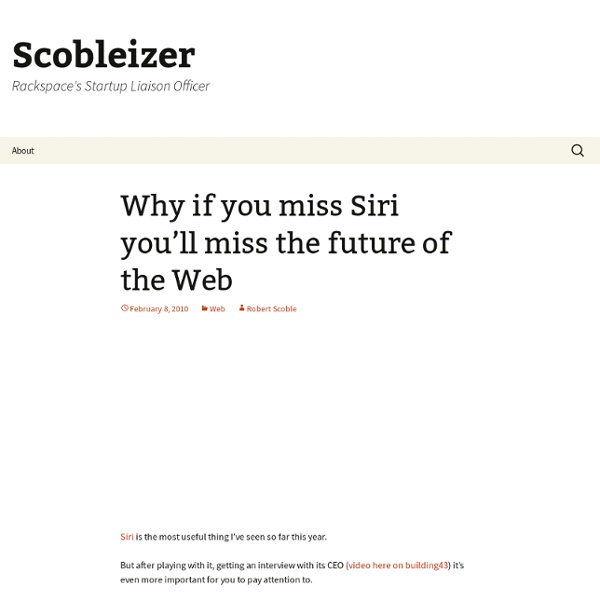Why if you miss Siri you’ll miss the future of the Web

iPhoneHeat
How To Use Google Voice On iPhone
How to restore iPhone app data from backup | iPhone Atlas
The iTunes App Store has been around for eight months and now lists more than 25,000 apps. If you're like me, you've probably purchased a dozen or more of these apps and hopefully, you're backing up your computer regularly to protect your purchases. But backups only work if you know how to use them to restore lost data. Frequently, the iPhone and iPod Touch require complicated restores and multiple layers of backup; this how-to will show you how to conquer the restore beast. Step 1: Reinstall your apps in iTunes A friend recently experienced a power failure that resulted in damage to his iTunes library file. iTunes automatically regenerated the file, but the iPhone and iPod Touch apps and their data were missing. We restored the apps easily from his backups and so they ended up where we expected them: Mac ~/Music/iTunes/Mobile Applications or Windows C:\Documents and Settings\USERID\My Documents\My Music\iTunes\Mobile Applications. Afterward, the apps synced again with the iPhone.
Transferring your iTunes Library
For most users, iTunes does a great job of handling all of the details of managing your media library for you, allowing you to manage your content through iTunes itself and not having to worry too much about the underlying files and folders that make up your iTunes library. Unfortunately, this user-friendly approach has one serious limitation: When it comes time to move your iTunes library, it can often be a bit of a challenge to figure out exactly what pieces you need to move and how to go about doing this. Many iTunes users start out with a basic iTunes library and use the default settings to store all of their media content on their primary internal hard drive. Another common scenario many users find themselves in is what to do when they upgrade to a new computer. How iTunes Manages Media Content The first and most important point is that iTunes is designed to handle all of the details of the underlying file system for you. iTunes: The Database versus the Content
iA » Designing for iPad: Reality Check
by Oliver Reichenstein Over the last two months we have been working on several iPad projects: two news applications, a social network, and a word processor. We worked on iPad projects without ever having touched an iPad. One client asked us to “start working on that tablet thing” even before we knew whether the iPad was real. Even though we developed everything inside the black box of Photoshop, it became quite clear that iPad application design is substantially different from web design in many ways. 1. The obvious issue with the resolution gap is typography. Is the font big enough? …we had no choice but to print out 1:1 scale mockups. Reality check: Wow, this thing is sharp! After two months of printing, we did get the typography pretty much right, but there was another surprise waiting for us: The sharpness. Web body text sizes (14-16px) feel too small on iPad, while bigger sizes clash with the canvas dimensions. Backgrounds and the delicate sound of noise 2. Using metaphors 3.
iPad 2 - is it True
for iPad is here!
Two months ago, we sat glued to our browsers as details of the iPad started streaming out of Apple’s launch event. It didn’t take us very long to formulate our official strategy for the new device: we were going to support the hell out of it, and we had 60 days to do it. Today is iPad launch day and as long lines start to form outside of Apple stores and UPS-Santa makes his rounds to sleepless geek households, we’re happy to say that Evernote for the iPad is live in the Apple AppStore! The new Evernote version (3.3) for Apple’s mobile devices is a universal binary that will run on all iPhone, iPod Touch and iPad devices. There aren’t many changes for iPhone / iPod Touch users in this version, but if you run it on an iPad you get a completely new user experience. Something to hold Designing the new interface was a daunting task. What should it be? We tried taking our existing iPhone UI and making it bigger. Things to try Views Scroll through all your notes in the “All notes” screen. Places
Siri And The iPhone’s Physical Keyboard
The backlash was inevitable. Siri has had a bit of an image problem this past week. Just like all technology propelled by the tailwinds of hype, it hit the inevitable wall of tech punditry. First of all, the downtime issue is a total red herring. That’s why stories demanding an explanation for Siri’s downtime are comical. The more interesting angle of the backlash goes after what Siri is and what Siri is not. Yet. Again, see: beta. The key is when Jordan also complains that she can often type faster than Siri can think. Now all of those people seem to happily be using iPhones (or Android phones) without physical keyboards without problems. What Siri represents is an extension of computing by utilizing something that (most) everyone has: voice. Everyone is amazed now when they see children interact with the iPad in such a natural way. But we’re not there yet. But maybe it’s hard to blame them. Does that mean speech replaces text input entirely? [image: CBS]
Related:
Related:



